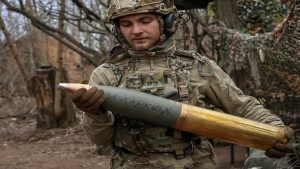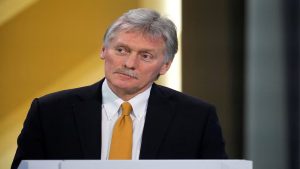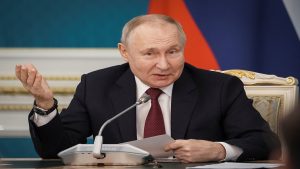Ukraine will need at least a decade to clear all the mines and explosives from its land and territorial waters once its war with Russia is over, an emergency services official said on Friday.
Ukraine has managed to clear 620 square kilometres of land that were littered with thousands of explosive devices, including 2 000 bombs dropped from the air, but nearly 300 000 square kilometres are still seen as “contaminated”, the official said.
That is an area roughly half the size of Ukraine’s territory, and about as large as Italy.
“Up to 10 years, that’s the optimistic figure. Because we don’t know what’s happening on the territories where active combat is ongoing right now,” Oleksandr Khorunzhiy, spokesperson for Ukraine’s State Emergency Service, said.
“Just imagine the number of bombs that have been dropped on us by the enemy,” the official told a news conference.
Russia invaded Ukraine on February 24 in what Moscow calls a “special military operation” to demilitarise Ukraine and rid it of dangerous nationalists. Ukraine and its allies dismiss this as a baseless pretext to launch an unprovoked war of aggression.
Ukraine set to withdraw from Sievierodonetsk as Russia closes in
Ukraine was set to pull its troops from the ruined city of Sievierodonetsk after weeks of street fighting and bombardment, the regional governor said, in what would be a significant gain for Russia as it grinds out its offensive in the east.
Russian troops also fully occupied a town about 10 km (6 miles) further south, Ukrainian officials said on Friday, as Moscow closed in on the last slivers of Ukrainian-held territory in the industrial region of Luhansk.
The reports came four months to the day since Russian President Vladimir Putin sent tens of thousands of troops over the border, unleashing a conflict that has killed thousands, uprooted millions and reduced whole cities to rubble.
The latest Russian advances appeared to bring the Kremlin closer to taking full control of Luhansk, one of Moscow’s stated war objectives, and set the stage for Sievierodonetsk’s twin city of Lysychansk to become the next main focus of fighting.
Luhansk regional governor Serhiy Gaidai said troops in Sievierodonetsk had already received the order to move to new positions.
“Remaining in positions smashed to pieces over many months just for the sake of staying there does not make sense,” Gaidai said on Ukrainian television.
NOTHING LEFT TO DEFEND
Russia invaded Ukraine on February 24, but abandoned an early advance on the capital Kyiv in the face of fierce resistance bolstered by Western arms.
Since then Moscow and its proxies have been focused on battles along the front line in Ukraine’s south and in Donbas, an eastern territory made up of Luhansk and its neighbour Donetsk.
Ukrainian forces had held out for weeks against an onslaught in Sievierodonetsk, trying to wear down Russian troops through attrition and buy time for the arrival of heavy weapons supplies.
“Our forces had to withdraw and conduct a tactical retreat because there was essentially nothing left there to defend. There was no city left there and, secondly, we could not allow them to be encircled,” Oleksander Musiyenko, a Kyiv-based military analyst, said.
Ukraine’s Defence Ministry said the Russians were trying to surround Lysychansk and mounting assaults on Sievierodonetsk to win full control. But spokesperson Oleksandr Motuzyanyk declined to comment on Gaidai’s remarks about a withdrawal.
South of Lysychansk, Russian troops had entered the town of Hirske and fully occupied the district on Friday, municipal head Oleksiy Babchenko said.
“There is a red flag flying over the municipal administration (in Hirske),” a spokesperson for the regional administration told Reuters by telephone.
Russia’s defence ministry said it had encircled up to 2,000 Ukrainian troops, including 80 foreign fighters, at Hirske.
Russian control of the Donbas region though proxy separatists would allow it to link up with Crimea to the south, which Moscow annexed from Ukraine in 2014.
But Ukraine’s foreign minister played down the significance of the possible loss of more territory in the Donbas.
“Putin wanted to occupy the Donbas by May 9. We are (there) on June 24 and still fighting. Retreating from a few battles does not mean losing the war at all,” Dmytro Kuleba said in an interview with the Italian newspaper Corriere della Sera.
He sounded pessimistic about the prospects of any peace talks soon.
“Only our military victory will convince Russia to engage in serious peace negotiations. Weapons will secure the diplomatic route,” Kuleba said.
ARMS AND DEFENCE
A senior U.S. defence official said Russia had been unable to stop Western weapons flowing into Ukraine, including longer-range systems that Kyiv hopes will still be decisive on the battlefield.
He also said the Ukrainians’ withdrawal from Sievierodonetsk could actually end up leaving them in a stronger position.
“What they are doing is putting themselves in a position where they can better defend themselves,” the official said, speaking on condition of anonymity.
Russia says it sent troops into Ukraine to degrade its southern neighbour’s military capabilities and root out people it called dangerous nationalists.
Ukraine says Russia has launched an imperial-style land grab and will never surrender its territory to Russia.
The war has had a massive impact on the global economy and European security arrangements, driving up gas, oil and food prices, pushing the EU to reduce its heavy reliance on Russian energy and prompting Finland and Sweden to seek NATO membership.
The U.N. nuclear watchdog said it was is increasingly concerned about the welfare of Ukrainian staff at the Russian-held Zaporizhzhia nuclear power plant in southeastern Ukraine, Europe’s largest.
The International Atomic Energy Agency has for months said that Zaporizhzhia, where Ukrainian staff are operating the plant under the order of Russian troops, poses a safety risk and that it wants to send a mission there.






